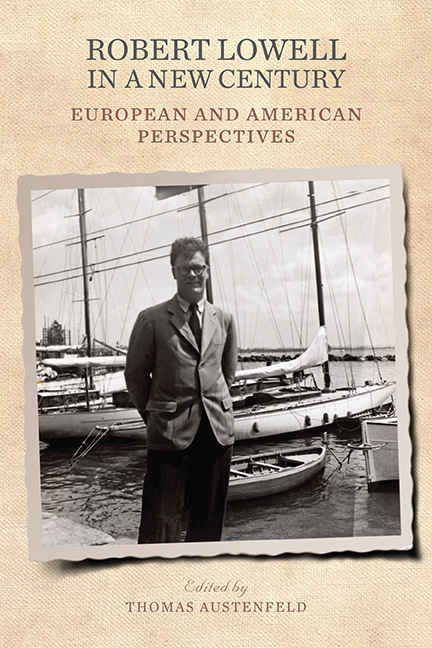Book contents
- Frontmatter
- Dedication
- Contents
- Acknowledgments
- Introduction
- 1 Revisiting Robert Lowell's Mental Hospital Poems
- 2 Sensual Drift and Ethnic Longing in Robert Lowell
- 3 Reworking the Same Water: Robert Lowell Transported
- 4 “Sweet salt embalms me”: A Hippocratic Approach to the Role of the Sea in the Poetry of Robert Lowell
- 5 More Delicate Than the Historian's Are the Map-Maker's Colors: Correspondences between Lowell's Poetics of History and Bishop's Poetics of Space
- 6 Robert Lowell and Ezra Pound's Economics
- 7 Robert Lowell and Ezra Pound in Washington and Rapallo
- 8 “Why Holland?”: Robert Lowell in Amsterdam
- 9 Lowell and Ungaretti: Imitations and Beyond
- 10 Robert Lowell's Credo
- 11 “Marriage? That's another story”: Reconsidering the Marital Trope in Robert Lowell's Poetry
- 12 “Oh No”/“Yes Yes”: Lowell and the Making of Mistakes
- 13 Robert Lowell: The Power of Influence
- Notes on Contributors
- Index
11 - “Marriage? That's another story”: Reconsidering the Marital Trope in Robert Lowell's Poetry
Published online by Cambridge University Press: 26 June 2019
- Frontmatter
- Dedication
- Contents
- Acknowledgments
- Introduction
- 1 Revisiting Robert Lowell's Mental Hospital Poems
- 2 Sensual Drift and Ethnic Longing in Robert Lowell
- 3 Reworking the Same Water: Robert Lowell Transported
- 4 “Sweet salt embalms me”: A Hippocratic Approach to the Role of the Sea in the Poetry of Robert Lowell
- 5 More Delicate Than the Historian's Are the Map-Maker's Colors: Correspondences between Lowell's Poetics of History and Bishop's Poetics of Space
- 6 Robert Lowell and Ezra Pound's Economics
- 7 Robert Lowell and Ezra Pound in Washington and Rapallo
- 8 “Why Holland?”: Robert Lowell in Amsterdam
- 9 Lowell and Ungaretti: Imitations and Beyond
- 10 Robert Lowell's Credo
- 11 “Marriage? That's another story”: Reconsidering the Marital Trope in Robert Lowell's Poetry
- 12 “Oh No”/“Yes Yes”: Lowell and the Making of Mistakes
- 13 Robert Lowell: The Power of Influence
- Notes on Contributors
- Index
Summary
Revisiting the Marriage Question
WHAT DO WE THINK ABOUT when we think about Robert Lowell and marriage? A little over a decade ago, Grzegorz Kosc provided an important reading of the topic with regard to what he called the “counseling” influence of William Carlos Williams on Lowell's work. In the wake of Jeffrey Meyers's publication of Robert Lowell in Love (2015), however, in which the poet's marriages and other romantic/sexual relationships are presented as the key to understanding the poet's art, the question demands fresh consideration. The question is also important because Lowell explores the topic of marriage in several poems—so much so that it is explicitly flagged in several of his poems’ titles, from “‘To Speak of Woe That Is in Marriage’” in Life Studies (1959) to “Marriage,” which is partly based on Jan Van Eyck's painting The Arnolfini Portrait (1434), in Day by Day (1977). The list of such poems also includes “Marriage” in History (1973) and “Marriage?,” the fourth sonnet in a group of five entitled “Caroline” in The Dolphin (1976). The Dolphin also includes a sixteen-sonnet sequence entitled “Marriage.” These poems and groups of poems in themselves signal Lowell's recurring concern with the question of marriage, and his sense of its complexity. This is to be expected, perhaps, of a poet who was himself married three times. When considering the issue of Lowell and marriage, indeed, our first impulse might be to refer to the poet's actual marriages to Jean Stafford, Elizabeth Hardwick, and Caroline Blackwood. It is undoubtedly useful to know that Lowell was married to Stafford in the 1940s, and the story of his marriage to Hardwick, from 1949 until their divorce in 1972, when he married Blackwood, is also a central part of the narrative of his artistic and cultural emergence.
The poet clearly used his experience of marriage to these three women as material for his work, but readers of Lowell—or any poet, for that matter—should also know that the relationship between life and art is never straightforward. The problem with Meyers's reading of Lowell is that he does not explore the complexity of this issue but, rather, sees the poems as providing what he calls an “autobiographical bounty” for the researcher.
- Type
- Chapter
- Information
- Robert Lowell in a New CenturyEuropean and American Perspectives, pp. 145 - 155Publisher: Boydell & BrewerPrint publication year: 2019



